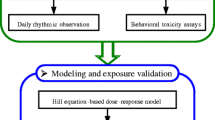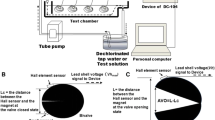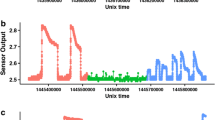Abstract
We developed an inductance-based valvometry technique as a detection system to measure the valve daily activity in freshwater clam Corbicula fluminea in response to waterborne arsenic. Our findings reveal that C. fluminea experiences a valve opening in the absence of arsenic predominantly in the morning hours (03:00–08:00) with a mean daily opening/closing period of 21.32 (95% CI: 20.58–22.05) h. Amplification of daily activity occurred in the presence of arsenic. Behavioral toxicity assays revealed arsenic detection thresholds of 0.60 (95% CI: 0.53–0.66) mg l−1 and 0.35 (95% CI: 0.30–0.40) mg l−1 for response times of 60 and 300 min, respectively. The proposed valve daily activity model was linked with response time-specific Hill dose-response functions to predict valve opening/closing behavior in response to arsenic. The predictive capabilities were verified satisfactory with the measurements. Our results implicate a biomonitoring system by valve daily activity in C. fluminea to identify safe water uses in areas with elevated arsenic.




Similar content being viewed by others
References
Ait Fdil M, Mouabad A, Outzourhit A, Benhra A, Maarouf A, Pihan JC (2006) Valve movement response of the mussel Mytilus galloprovincialis to metals (Cu, Hg, Cd and Zn) and phosphate effluents from Moroccan Atlantic coast. Ecotoxicol 15:477–486. doi:10.1007/s10646-006-0083-3
APHA (2005) Standard methods for the examination of water and wastewater, 20th edn. American Public Health Association, Washington
Chen CJ, Hsu LI, Wang CH, Shih WL, Hsu YH, Tseng MP et al (2005) Biomarkers of exposure, effect, and susceptibility of arsenic–induced health hazards in Taiwan. Toxicol Appl Pharmacol 206:198–206. doi:10.1016/j.taap.2004.10.023
Cherry DS, Soucek DJ (2007) Case study: comparison of Asian clam (Corbicula fluminea) in situ testing to several nontarget test organism response to biocidal dosing at a nuclear power plant. In: Farris JL, van Hassel JH (eds) Freshwater bivalve ecotoxicology. Roca Raton, London, NY, pp 285–310
Dell’Omo M (2002) Behavioural ecotoxicology. Chichester, New York, p 463
Gerhardt A, De Bisthoven LJ, Soares AMV (2005) Evidence for the stepwise stress model: Gambusia holbrooki and Daphnia magna under acid mine drainage and acidified reference water stress. Environ Sci Technol 39:4150–4158. doi:10.1021/es048589f
Gerhardt A, de Bisthoven LJ, Schmidt S (2006) Automated recording of vertical negative phototactic behaviour in Daphnia magna Straus (Crustacea). Hydrobiologia 559:433–441. doi:10.1007/s10750-005-1259-1
Huang YK, Lin KH, Chen HW, Chang CC, Liu CW, Yang MH et al (2003) Arsenic species contents at aquaculture farm and in farmed mouthbreeder (Oreochromis mossambicus) in blackfoot disease hyperendemic areas. Food Chem Toxicol 41:1491–1500. doi:10.1016/S0278-6915(03)00165-0
Jou LJ, Liao CM (2006) A dynamic artificial clam (Corbicula fluminea) allows parsimony on-line measurement of waterborne metals. Environ Pollut 144:172–183. doi:10.1016/j.envpol.2005.12.032
Lamm SH, Engel A, Penn CA, Chen R, Feinleib M (2006) Arsenic cancer risk confounder in southwest Taiwan data set. Environ Health Perspect 114:1077–1082
Liao CM, Chen BC, Singh S, Lin MC, Han BC (2003) Acute toxicity and bioaccumulation of arsenic in tilapia Oreochromis mossambicus from blackfoot disease area in Taiwan. Environ Toxicol 18:252–259. doi:10.1002/tox.10122
Liao CM, Jou LJ, Chen BC (2005) Risk-based approach to appraise valve closure in the clam Corbicula fluminea in response to waterborne metals. Environ Pollut 135:41–52. doi:10.1016/j.envpol.2004.10.015
Lin MC, Liao CM, Liu CW, Singh S (2001) Bioaccumulation of arsenic in aquacultural large-scale mullet Liza macrolepis from blackfoot disease area in Taiwan. Bull Environ Contam Toxicol 67:91–97
Lin MC, Lin HY, Cheng HH, Chen YC, Liao CM, Shao KT (2005) Risk assessment of arsenic exposure from consumption of cultured milkfish, Chanos chanos (Forsskål), from the arsenic-contaminated area in southwestern Taiwan. Bull Environ Contam Toxicol 75:637–644. doi:10.1007/s00128-005-0800-2
Liu CW, Liang CP, Huang FM, Hsueh YM (2006) Assessing the human health risks from exposure of inorganic arsenic through oyster (Crassostrea gigas) consumption in Taiwan. Sci Total Environ 361:57–66. doi:10.1016/j.scitotenv.2005.06.005
Liu CW, Liang CP, Lin KH, Jang CS, Wang SW, Huang YK et al (2007) Bioaccumulation of arsenic compounds in aquacultural clams (Meretrix lusoria) and assessment of potential carcinogenic risk to human health by ingestion. Chemosphere 69:128–134. doi:10.1016/j.chemosphere.2007.04.038
Newton TJ, Cope WG (2007) Biomarker responses of unionid mussels to environmental contaminants. In: Farris JL, van Hassel JH (eds) Freshwater bivalve ecotoxicology. Roca Raton, London, pp 257–284
Ortmann C, Grieshaber MK (2003) Energy metabolism and valve closure behaviour in the Asian clam Corbicula fluminea. J Exp Biol 206:4167–4178. doi:10.1242/jeb.00656
Sluyts H, van Hoof F, Cornet A, Paulussen J (1996) A dynamic new alarm system for use in biological early warning system. Environ Toxicol Chem 15:1317–1323. doi:10.1897/1551-5028(1996)015<1317:ADNASF>2.3.CO;2
Tran D, Ciret P, Ciutat A, Durrieu G, Massabuau JC (2003) Estimation of potential and limits of bivalve closure response to detect contaminants: application to cadmium. Environ Toxicol Chem 22:914–920. doi:10.1897/1551-5028(2003)022<0914:EOPALO>2.0.CO;2
Tran D, Fournier E, Durrieu G, Massabuau JC (2004) Copper detection in the freshwater clam Corbicula fluminea: optimum valve closure response. Aquat Toxicol 66:333–343. doi:10.1016/j.aquatox.2004.01.006
Tran D, Fournier E, Durrieu G, Massabuau JC (2007) Inorganic mercury detection by valve closure response in the freshwater clam Corbicula fluminea: integration of time and water metal concentration changes. Environ Toxicol Chem 26:1545–1551. doi:10.1897/06-390R1.1
van der Schalie WH, Sheld TR, Knechtges PL, Widder MW (2001) Using higher organisms in biological early warning systems for real-time toxicity detection. Biosens Bioelectron 16:457–465. doi:10.1016/S0956-5663(01)00160-9
Acknowledgments
The authors acknowledge the National Science Council of Republic of China for financial support under the Grant NSC 95-2313-B-002-052-MY3. We also thank Biosystems Modeling and Control Lab members for assistance with collection of field samples and assays. This work was inspired by the original paper appeared in Environmental Toxicology and Chemistry 22: 914-920 (2003) by Dr. Tran and coworkers.
Author information
Authors and Affiliations
Corresponding author
Rights and permissions
About this article
Cite this article
Liao, CM., Jau, SF., Lin, CM. et al. Valve movement response of the freshwater clam Corbicula fluminea following exposure to waterborne arsenic. Ecotoxicology 18, 567–576 (2009). https://doi.org/10.1007/s10646-009-0314-5
Received:
Accepted:
Published:
Issue Date:
DOI: https://doi.org/10.1007/s10646-009-0314-5




